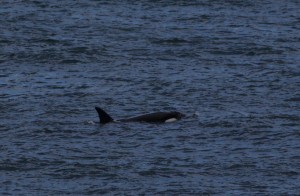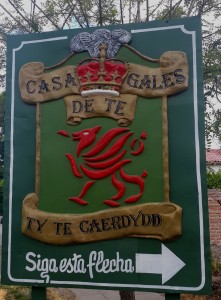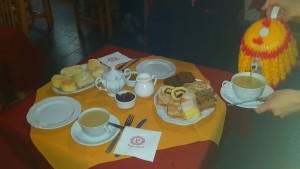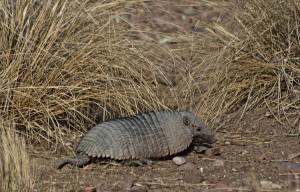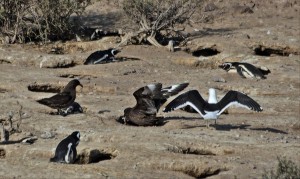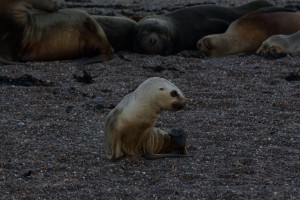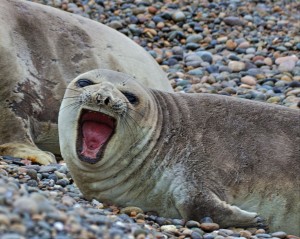 It’s a loooong way south through Patagonia. From BA to Ushuaia at the bottom of the continent, it’s over 3,000 km in fact, so we won’t be doing it in an afternoon. We’re heading down the eastern side of Argentina, across miles and miles (and miles) of vast, flat pampas land. It is featureless, but strangely all the more beautiful for this. We’re in no hurry and will be taking it slowly, in short hops down the coast – apparently there are a few land and sea critters to watch 🙂
It’s a loooong way south through Patagonia. From BA to Ushuaia at the bottom of the continent, it’s over 3,000 km in fact, so we won’t be doing it in an afternoon. We’re heading down the eastern side of Argentina, across miles and miles (and miles) of vast, flat pampas land. It is featureless, but strangely all the more beautiful for this. We’re in no hurry and will be taking it slowly, in short hops down the coast – apparently there are a few land and sea critters to watch 🙂
Some 3-4 hours south of BA, the pancake landscape is broken by the small Sierra de la Ventana. In UK we would call these ‘mountains’, but rising to only 1,200m, on this continent of the Andes they are barely molehills. Nevertheless, they are rather attractive molehills with the eponymous window rock-formation.
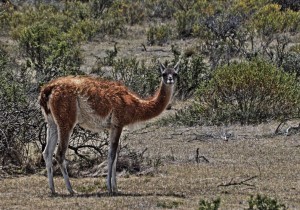 After Bahia Blanca we press-on south past Viedma and the world’s largest colony of parrots – thousands of them living in and around the cliffs. Driving along the RP1 gravel coast-road through Rio Negro province we see our first wild roaming guanacos (a type of llama) and rheas (bit like a small ostrich) 🙂 . No doubt we will be seeing a few more of these chaps around South America!
After Bahia Blanca we press-on south past Viedma and the world’s largest colony of parrots – thousands of them living in and around the cliffs. Driving along the RP1 gravel coast-road through Rio Negro province we see our first wild roaming guanacos (a type of llama) and rheas (bit like a small ostrich) 🙂 . No doubt we will be seeing a few more of these chaps around South America!
From Whales to Welsh
Pushing on south again we head down to Peninsular Valdes – this is where Patagonia properly starts! On the map the Valdes Peninsula looks like a small blobby mole on Argentina’s right side, jutting out into the South Atlantic; on the ground it is a flat almost featureless terrain but with amazing marine and wild-life around the beaches. In the centre are some large pristine-white salt-pans where our GPS altimeter indicated 20m below sea level; we reckoned that this was the lowest that Cuthbert has been, OK… that’s if you don’t count his trips under the English Channel through the Euro-tunnel. The expanse of the salt pans is impressive and the salt-white is dazzling in the bright sunshine, but hopefully not as impressive as it’s celebrated and (much) bigger brother, the vast Salar de Uyuni in Bolivia – on our itinerary for next year… sometime!
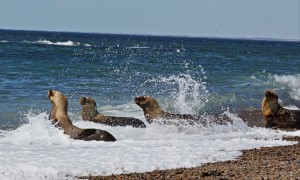 The beaches on Peninsula Valdes are famous for whales, orcas, penguins, sea-lions and elephant seals… quite exciting! We parked up for the night on one of the rocky points and were thrilled to see a couple of Southern Right Whales playing around in front of us as we were eating dinner in Cuthbert. The next day we saw a colony of Magallanic Penguins, then a group (is it a herd?) of elephant seals with some huge, monster-sized, alpha-males fighting on the beach. Amid a loud noise of what is probably best described as a ‘screeching-grunt’ they thwack their upper bodies against each other with tremendous force, sending rippling waves of blubber down the length of their torsos. The odd thing is that periodically, they both suddenly take a bit of ‘time out’: they stop fighting and lie next to each other, motionless in the sun for a while, then just as suddenly they grunt at each other, spring back to life and continue the fight. How funny would it be to see humans do this in martial arts, boxing or wrestling matches??? 🙂
The beaches on Peninsula Valdes are famous for whales, orcas, penguins, sea-lions and elephant seals… quite exciting! We parked up for the night on one of the rocky points and were thrilled to see a couple of Southern Right Whales playing around in front of us as we were eating dinner in Cuthbert. The next day we saw a colony of Magallanic Penguins, then a group (is it a herd?) of elephant seals with some huge, monster-sized, alpha-males fighting on the beach. Amid a loud noise of what is probably best described as a ‘screeching-grunt’ they thwack their upper bodies against each other with tremendous force, sending rippling waves of blubber down the length of their torsos. The odd thing is that periodically, they both suddenly take a bit of ‘time out’: they stop fighting and lie next to each other, motionless in the sun for a while, then just as suddenly they grunt at each other, spring back to life and continue the fight. How funny would it be to see humans do this in martial arts, boxing or wrestling matches??? 🙂
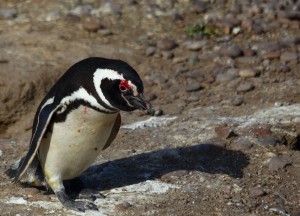 Probably our best time on the Peninsula was spent watching four Orcas hunting seals in the surf just a few metres off the beach in front of us. We watched them cruising up and down the shoreline for an hour or so hoping that they might try a lunge out of the surf and up the beach to grab a seal lounging on the sand, but no luck with that one today. Oh well… fingers crossed we will hopefully see this somewhere on the beaches further south.
Probably our best time on the Peninsula was spent watching four Orcas hunting seals in the surf just a few metres off the beach in front of us. We watched them cruising up and down the shoreline for an hour or so hoping that they might try a lunge out of the surf and up the beach to grab a seal lounging on the sand, but no luck with that one today. Oh well… fingers crossed we will hopefully see this somewhere on the beaches further south.
After Peninsular Valdes and a stop-over in Puerto Madryn for some shopping and laundry admin (incidentally, finding a laundrette has been sooo easy here so far, not like in Africa where we had to do most of it by hand and hang out to dry, a la 1950s housewife 🙂 ) we are back on the sea-shore at Punta Ninfa to the south of town and find a marvellous spot to climb down the cliffs. The descent is a bit precarious, involving a rope ladder which has been pegged into the rock-face to descend one section, but at the bottom we see a colony of elephant seals closer up… and before we receive the angry emails… yes, we did of course keep a respectful distance so as not to disturb them, and all the photos here are taken from a distance with a long lens!
Over breakfast at Punta Ninfa we watch a Southern Right Whale playing just off shore, but once he is gone, we leave the whales to head inland for a Welsh experience!
So… ‘Whales’ and ‘Welsh’ – nice link huh??? 🙂 . Well… you probably won’t get the pun unless for some reason you are aware that curiously, there exists in a corner of Argentina, a community descended from the Welsh settlers of 1860 and which still maintains the Welsh language and culture. All around the village, signs are bi-lingual in Spanish and Welsh and Welsh really is still spoken here by descendants of the original settlers. A firm fixture on the travellers’ route down the eastern coast of Argentina is to stop in the village of Gaiwan and take afternoon tea, Welsh style. This includes fresh home-made barra brith, welsh cakes, scones, lemon sponge, custard cream, jam roly-poly, plus a large pot of ‘proper’ tea with a hand-crochet tea-cosy like gran used to have. It is rather peculiar to find this tradition in rural Patagonia, but this week it is apparently the 20th anniversary of the time when in 1995, the then Princess of Wales no less, visited Gaiwan to take her afternoon tea. What’s good enough for Di is good enough for us 🙂
Penguin fight-night
After the Welsh we moved on further down the coast. Cabo Dos Bahias provides, for our entertainment, delectation and delight, a very large colony of over 25,000 mating couples of Magellanic penguins. It’s nesting time and the penguin couples each seem to be taking it in turns to warm the eggs ready for hatching in the next couple of weeks.
We’d never really thought of penguins as being noisy critters, but boy did these guys make a din! First, they seem to take a deep breath, then pull themselves up to their full height, puff-out their chest and throw their head back to straighten their throat vertically to the sky, opening their beaks wide and letting out an almighty, loud ‘braying’ noise that would shame a donkey! It’s a cacophony of noise when a few start ‘in harmony’!
Now… you don’t get 25,000 couples of any species, living in such close proximity without a bit of aggro, and the Magellanes Penguin is no exception! A highlight for our afternoon there, was to witness a ‘penguin street-fight’!! It all started, as it usually does, with a couple of blokes having a go at each other. There was a bit of squawking and pecking which slowly became louder and more aggressive. They went at each other ‘hammer & tongs’, occasionally knocking each other over and getting up again to continue the fight. As the fighters staggered around, dazed in the struggle, other penguins gathered around to squawk at them (presumably along the lines of… ‘Leave him Wayne… he’s not worth it’ 🙂 ). In their struggle, the fighters inadvertently toppled together, head-first into the nest of another couple, who naturally fought back hard to defend their hatchling eggs. Trying not to get involved in the fight, they squawked loudly and tried to shove the fighters away with their flippers. Eventually the fighters split, but it seemed to us from the gash-wounds and blood on their glossy white plumage that it was the Champ (i.e. he with the least serious wounds) who ran away. Wow… ‘Eastenders meets Attenborough’ – fascinating and engaging stuff!! 🙂 We managed to get a bit of video footage of the fight, included in our photo gallery at the bottom of this page.
We watched the penguins’ sometimes human-like interactions with each other, we saw the rheas and llamas wandering amongst the penguins, we spotted an armadillo scuttling between the penguin nests unsuccessfully looking for an unguarded nest from which to snaffle an egg. Armadillos are predominantly nocturnal animals, so we were very chuffed to see one.
We also saw a bird of prey circling overhead the penguins’ nests. The bird (in our ignorance of ornithology, we will refer to him respectfully as ‘Mr Bird’ 🙂 ) happens to be a better hunter than the armadillo: when one of the nesting penguins dropped its guard momentarily, Mr Bird spotted his opportunity and swooped in from the sky, lightning fast. The poor penguin could only squawk helplessly as Mr Bird quickly jutted its head into the nest and swiftly raising the egg in its beak then flew away 🙁 . A bit sad, but it is, as they say, ‘dog-eat-dog’ out there!
Sadly we were just a bit too early in the season to see the hatching and the fluffy baby pingus that should be arriving in the colony soon. If you happen to be passing in the next couple of weeks, you may wish to drop in to say ‘hi’ to a few thousand pingu chicks 🙂
Seeing Sea-lions
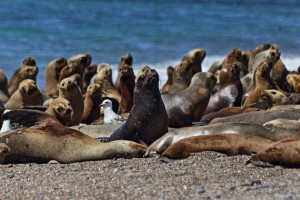 In addition to ‘The Great Penguin-Egg Heist’, another cruel side of nature revealed itself as we parked up by a beach to watch a colony of sea-lions near Caleta Olivia. “But Hey! …” you say… “How did you know they were sea lions and not large elephant seals?”. That’s a very good question, thank you for asking 🙂 . To the untrained eye, they do indeed look quite similar, especially the females and from a distance when they are lying down. But we did our reading back at Peninsular Valdes and are now somewhat ‘au-fait’ and ‘smarty-pants’ with these things! Sea-lions have limb-like flipper-legs at the back on which they can walk, as opposed to seals which have only a split-finned tail flipper (clearly we have yet to learn the correct zoologically terminology here, but you get the idea 🙂 ).
In addition to ‘The Great Penguin-Egg Heist’, another cruel side of nature revealed itself as we parked up by a beach to watch a colony of sea-lions near Caleta Olivia. “But Hey! …” you say… “How did you know they were sea lions and not large elephant seals?”. That’s a very good question, thank you for asking 🙂 . To the untrained eye, they do indeed look quite similar, especially the females and from a distance when they are lying down. But we did our reading back at Peninsular Valdes and are now somewhat ‘au-fait’ and ‘smarty-pants’ with these things! Sea-lions have limb-like flipper-legs at the back on which they can walk, as opposed to seals which have only a split-finned tail flipper (clearly we have yet to learn the correct zoologically terminology here, but you get the idea 🙂 ).
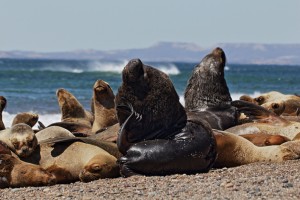 When you first see a colony of sea-lions, it can look a bit like some kind of Armagheddon has taken place on the beach; piles of still, motionless bodies flopped randomly all over the shore with just the odd grunt and the occasional stirring of a flipper to scratch an itch. Eventually something happens… one sea-lion stirs, and another, then another… soon the whole herd has its head up, looking around and barking. Some then waddle down to the sea, others flop back down onto the beach to sleep, soon to be rudely clambered over by the others taking the most direct route to the sea. They are comical to watch and we had an entertaining afternoon sitting on the beach with them.
When you first see a colony of sea-lions, it can look a bit like some kind of Armagheddon has taken place on the beach; piles of still, motionless bodies flopped randomly all over the shore with just the odd grunt and the occasional stirring of a flipper to scratch an itch. Eventually something happens… one sea-lion stirs, and another, then another… soon the whole herd has its head up, looking around and barking. Some then waddle down to the sea, others flop back down onto the beach to sleep, soon to be rudely clambered over by the others taking the most direct route to the sea. They are comical to watch and we had an entertaining afternoon sitting on the beach with them.
But we digress… back to our story about the cruel side of nature. In our observations we spotted a young and very skinny pup lying on the beach some distance from the main pack. He looked very small and weak compared to the other pups that were playing together in the waves nearby. Over a few hours we saw him slowly get up and wander over to the pack, sniffing at the tummies of several females apparently trying to find one with some milk. Eventually he settled and snuggled next to a female which seemed to be his mother, but she appeared as lethargic, thin and unwell as he was. She was heaving and vomiting and could barely lift her head. She wasn’t able to look after him and none of the other mums seemed willing to adopt him. Eventually the pup got up again on his own and wandered listlessly down to the shore. It was a heart-breaking sight and we expect that within a few days these two will both be joining the big aqua-park in the sky 🙁
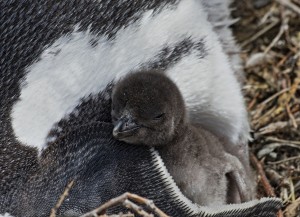 Moving on further south again for hundreds of miles, Patagonia’s beaches and coves filled with marine life seem never ending! Near Puerto Julian we parked up on what initially seemed to be an empty pebble beach, only to be entertained within minutes by three Commerson dolphins playing in the surf in front of us; then came a lone sea-lion waddling out of the surf up the beach. We could drop into a blasé “Oh yes, just another whale/sea-lion/seal/dolphin… whatever!” but we still get excited at each one we see. Marvellous!
Moving on further south again for hundreds of miles, Patagonia’s beaches and coves filled with marine life seem never ending! Near Puerto Julian we parked up on what initially seemed to be an empty pebble beach, only to be entertained within minutes by three Commerson dolphins playing in the surf in front of us; then came a lone sea-lion waddling out of the surf up the beach. We could drop into a blasé “Oh yes, just another whale/sea-lion/seal/dolphin… whatever!” but we still get excited at each one we see. Marvellous!
Next at Monte Leon, another colony of Magellanic penguins and this time… Bingo!! Some chicks had hatched!! We’ve never seen such tiny little bundles of fluff, sooooo cute 🙂 . Having satisfied our itch to see the pingu chicks, we’re moving on even further south.
Soon we’ll cross the Magellan Straights into Tierra del Fuego… ‘the End of the Earth’!
Link to next blog: Far South Argentina – to the end of the world
Link to full South America Blog
East Coast Gallery
We took so many pictures and video clips on this section of our trip. Here’s a selection of the scenery, penguins, sea-lions, seals etc, plus… the short clip of the Penguin fight 🙂

